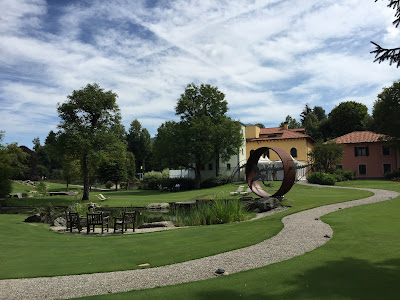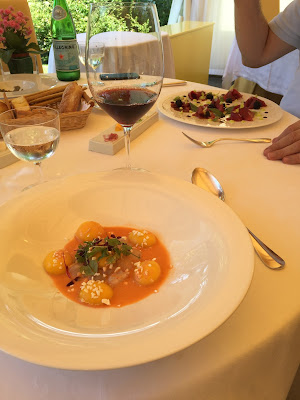Temple of Neptune at Paestum
The most exciting part of being in Southern Italy is the
chance to visit the best-preserved, oldest remains of ancient Greek culture
outside of Greece, what the Roman geographer Strabo called Magna Graecia, (=Great Greece). Paestum, the site of the original
Greek colony of Poseidonia, boasts the three best preserved, magnificent Doric
temples, surrounded by the ruins of Greek, Lucanian, and Roman buildings.
We set aside a full day in early October, hired a driver to
pick us up at Minori at 8:30 am for the two-hour drive south along the Amalfi
coast, which was a gorgeous scenic route with the sparkling Tyrrhenian Sea on
our right and clusters of villages clinging to the cliffs on our left. We passed Salerno, a significant port city
with a modern Maritime Terminal Station for cruise ships and for loading and
unloading container ships.
At last we arrived at Paestum, thankfully not overrun with
tourists. In fact, other than for some Italian tour groups, we had the place
mostly to ourselves. After obtaining entrance
tickets in the Museo Archeologico
Nazionale of Paestum, we crossed the road to the main gate.
The Temple of Ceres dominated the northern end of the
complex, and we approached it with cameras and cell phones ready. This
sanctuary, built in about 500 BC on the foundations of an older temple from 580
BC, was mistakenly attributed to the earth goddess Ceres by the 18th
century scholars. Modern research has
uncovered evidence that it was really dedicated to Athena, and when the Romans
took over the site, continued the dedication to Minerva, the Roman Athena.
This temple has a more ‘classical’ Greek look, the columns
are more slender than standard Doric, and the ‘cella’ was surrounded with Ionic columns, with several sandstone Ionic
capitols on display outside the temple, making this temple an example of the
transition from archaic to early classicism. The cella was the inner chamber that held the oversize votive statue of
the goddess, nothing of which now remains.
This elegant structure, as high as a three-story building, with
six columns on short side and 14 on the long, glowed in the late-morning sun
against the deep blue of the sky. The western façade has more of the triangular
pediment surviving; the damaged eastern pediment was partially restored in
1828. On the north side of the building
there were the remains of medieval tombs, indicating that the temple had been
used as a Christian church before Paestum was abandoned in the 9th
century.

Along the eastern edge of the Temple of Athena, a Roman
road, the “Via Sacra” leads south
toward the two other massive temples.
Walking along we passed the open areas of the Greek Agora, the Roman
Forum, and a strange structure in a small walled garden that looked like a house,
nearly-submerged in the soil, with only the pitched roof above ground. Called the Heroon-Cenotaph, this was an underground sanctuary dedicated to the
un-named Greek founder of Poseidonia, in which the excavators found wonderful
artifacts which are on display in the museum.
Soon we reached the amazing ‘Temple of Neptune, so named because
it seemed to the excavators that the most imposing temple should be dedicated
to the god for whom the city was named: Poseidon/Neptune. I expected to be
overwhelmed by this best-preserved Doric temple in Magna Graecia, and was not
disappointed.
Temple of Neptune
The temple stands on a
base three giant steps above the ground, the façade holds six massive columns
and the long side has 13 columns. These thick
columns are clearly Doric, almost nine meters high, carved with 24 flutes to
slenderize, displaying the ‘entasis’ -
that technique where the columns have a slight curved bulge in the middle
narrowing at the top. The capital on top
of the column was a simple flaring structure supporting a square slab called an
abacus. The horizontal stone beams called the
entablature, showed the alternating pattern of the triglyphs separated by spaces where the metope (usually a carved figure in relief) would be inserted. The triglyph is the section along the roof
that recalls the appearance of the end of wooden beams, timber being the
original material the Greeks used to build their temples. This use of stone to mimic lumber even carried
over to the six pegs, called guttae,
carved in the stone below each triglyph!


The inner chamber, the cella,
was reached by climbing stone steps, and displayed the stone slabs that probably
held the cult statue. The inside ceiling had been wooden but the outside gabled
roof was probably covered by tiles, nothing of which remains. The limestone of the base slabs, the columns
and what remained of the entablature took on a warm terracotta color in the
sunlight, separating the blue sky, making for a breathtaking sight. I couldn’t
resist stroking with my hands the columns of this building, almost 2600 years
old.
The southernmost temple, called the Basilica, was estimated
to be the oldest, built in 550 BC. When
Paestum was rediscovered in the 18th century, after a thousand years
of neglect, the excavators thought it was a building for civic, not religious
use and called it a basilica.
Basilica (Temple of Hera)
Basilica (Temple of Hera) with Temple of Neptune in distance
This
temple looks archaic, nine columns on the front and 18 along the side, with 20 shallow
flutes on the columns, topped with a wide mushroom-shaped capital. Nothing remains of triglyphs or metopes on
the entablature, but the museum contains fragments of polychrome terracotta
decoration from the roof. The cella
was divided into two rooms, and votive offerings uncovered by excavators
indicate an attribution to the goddess Hera.
When the Romans took over the city, this temple was dedicated to Juno,
identified with the Greek Hera.
Amphitheatre
Returning to the entrance we passed an amphitheatre, and a
building called the Bouleuterion, dating
from 470 BC, which was dug out of the rock in a series of concentric tiers, where
assemblies of citizens could meet.
Tomb Painting
Triglyph and metope in museum
There was just enough time for a quick visit to the Museo Archeologico Nazionale, which held
the ancient treasures of Paestum. The most famous may be the tomb-painting on
the Tomb of the Diver, which was not Greek, but from the period when Paestum
was a Lucanian city. The Lucanians
favored tomb painting, and the museum held many examples, in addition to vases,
weapons, jewelry, carved friezes, and statuary.
One hall in the museum held a reconstruction of the roofline of the
Temple of Ceres, showing the original polychrome decoration on the gables.



The present building dates from 1952, replacing an earlier
smaller museum that had been out-grown as more and more artifacts were
uncovered. I read more about the history of Paestum, that it was founded by the
Greek colonists from Sybaris in about 600 BC, and became extraordinarily
wealthy on the trade routes across the “toe” of Italy. When Sybaris was
destroyed by Crotona in 510 BC, Poseidonia became a refuge for the citizens of
Sybaris. The Italic tribe of Lucanians gained control of Poseidonia in about
390 BC, and republican Rome made it a colony in 273 BC, renaming it Paestum.
The city declined in the years of the Roman Empire, the river port silting up
and the land gradually turning into malarial swamps. When Paestum was sacked by
Muslim raiders in 871 AD the city was finally abandoned, forgotten until the 18th
century. What we toured was just a fraction
of the ancient city; the rest lies unexplored under private land and a road
built in the days of the Bourbon monarchs of Italy.
When our driver returned to pick us up, he congratulated us
on taking the time to visit Paestum, saying most foreign tourists to Naples and
Amalfi do not think past Pompeii and Herculaneum. I assured him we intrepid trekkers enjoy the “off
the beaten path” discoveries!





















































